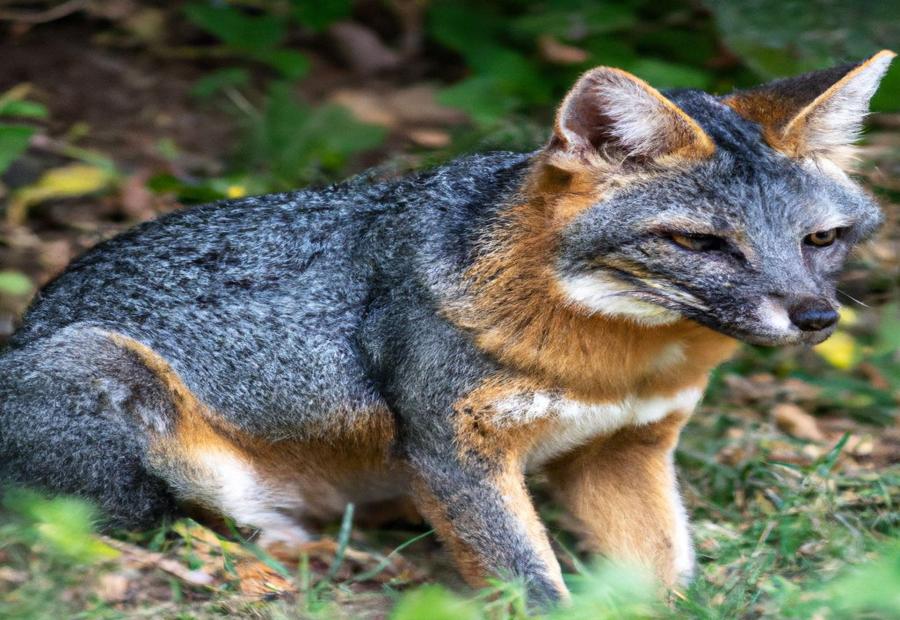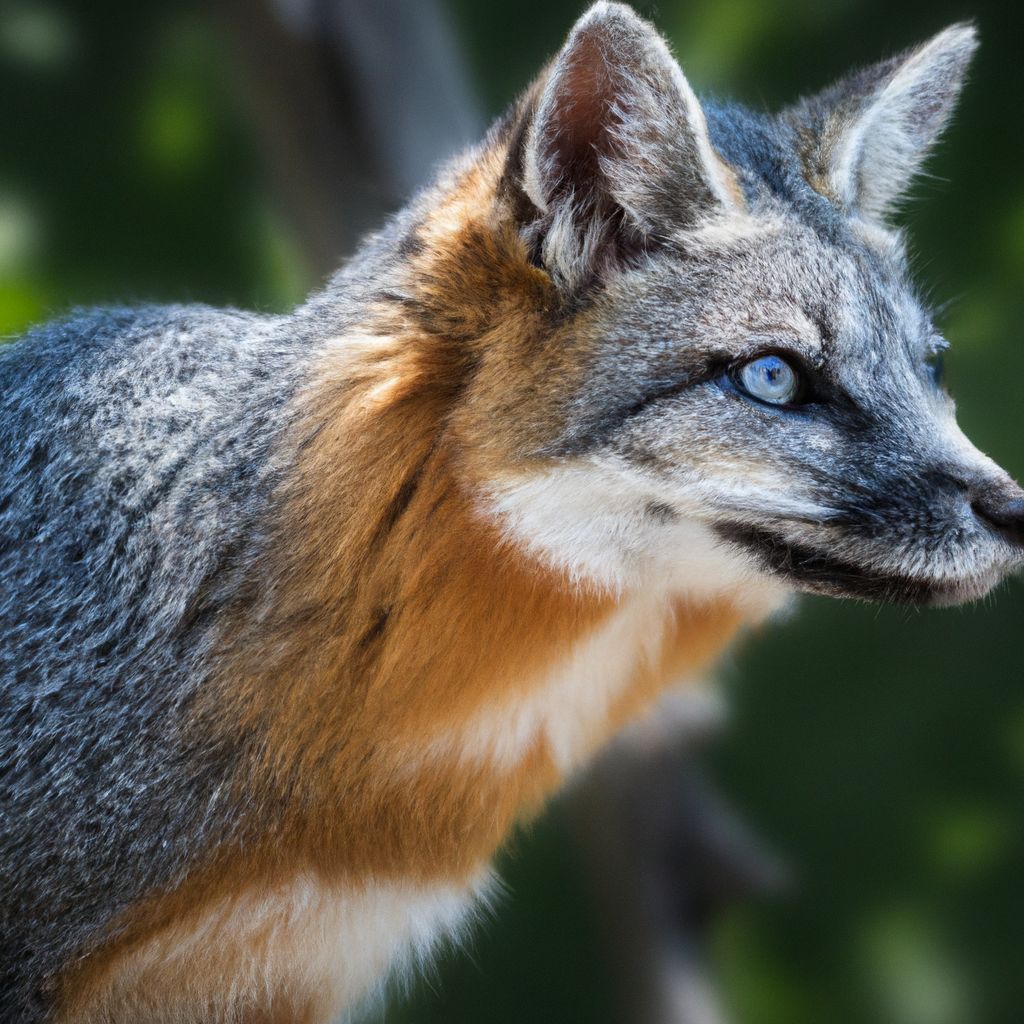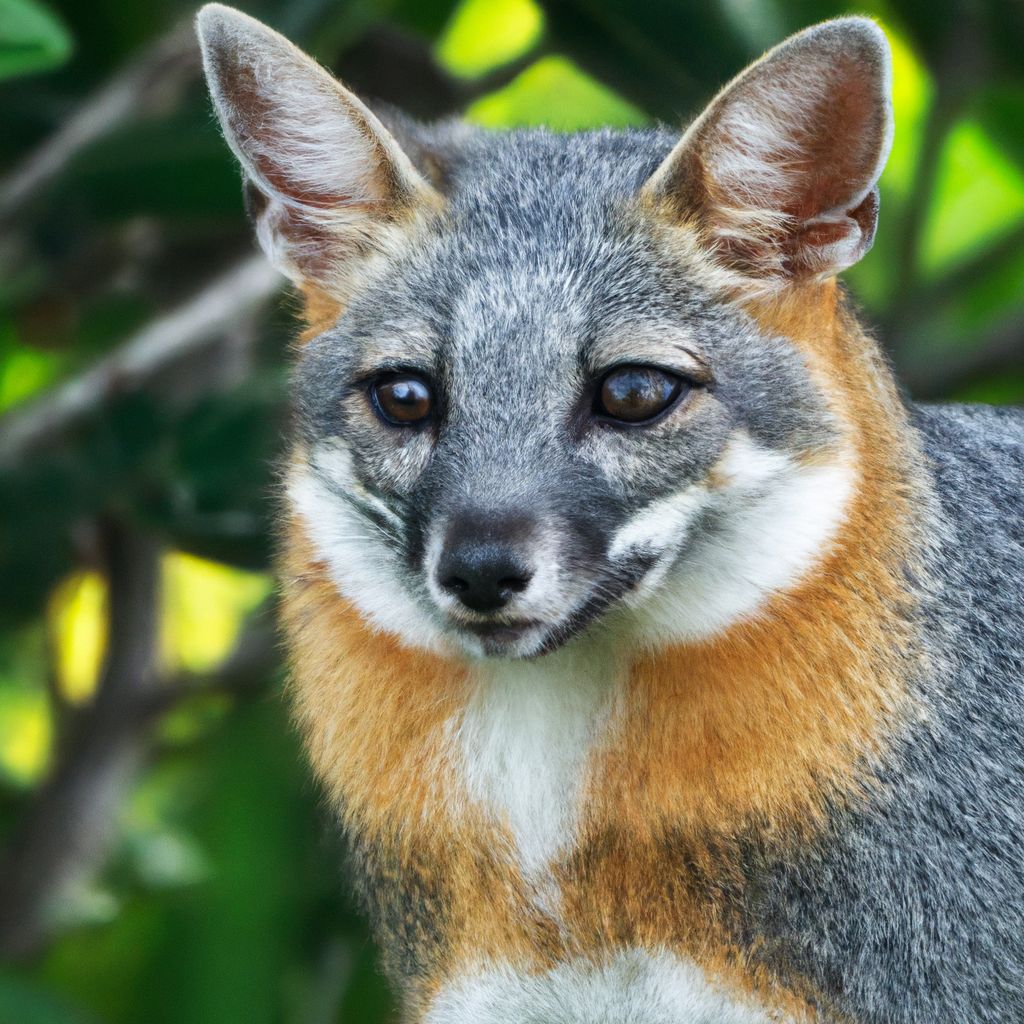The gray fox, known for its unique adaptations and survival tactics, is a fascinating species worth exploring. This article aims to provide an in-depth understanding of the remarkable characteristics and behaviors that enable the gray fox to thrive in its environment.
By referencing reputable scientific studies and wildlife experts, we will delve into the physical and behavioral adaptations of the gray fox, including its fur coloration for camouflage, climbing abilities, and adaptations for hunting.
We will explore the unique features of the gray fox, such as its semi-retractable claws, rotating wrist bones, and vocal communication. Understanding the survival tactics employed by the gray fox, such as its nocturnal behavior, denning habits, and avoidance and escape techniques, will shed light on its ability to navigate and survive in various habitats.
Furthermore, we will examine the interactions of the gray fox with other animals, including its prey and predators, as well as competition for resources. Finally, we will discuss the conservation status of the gray fox and the threats it faces, such as habitat loss, human encounters, and disease and parasites. Through this exploration, we will gain a comprehensive insight into the fascinating world of the gray fox and its role in disease transmission and the strategies it employs to ensure its survival.
Contents
- 1 Key takeaway:
- 2 Physical and Behavioral Adaptations
- 3 Unique Features of Gray Fox
- 4 Survival Tactics of the Gray Fox
- 5 Interactions with Other Animals
- 6 Conservation Status and Threats
- 7 Frequently Asked Questions
- 7.1 1. What is the scientific name of the Gray Fox?
- 7.2 2. How does the Gray Fox adapt to loss of habitat?
- 7.3 3. What is the average lifespan of the Gray Fox?
- 7.4 4. How does the Gray Fox communicate with each other?
- 7.5 5. Can the Gray Fox climb trees?
- 7.6 6. How is the Gray Fox impacted by fox penning?
Key takeaway:
- The Gray Fox utilizes unique physical and behavioral adaptations for survival: Its fur coloration helps it blend into its surroundings, its climbing abilities allow it to navigate different environments, and its hunting adaptations make it an efficient predator.
- The Gray Fox possesses distinctive features: It has semi-retractable claws that aid in climbing and hunting, rotating wrist bones that add flexibility, and vocal communication to communicate with other foxes.
- The Gray Fox employs various survival tactics: It is primarily nocturnal to avoid predators, it dens in secluded areas for protection, and it utilizes avoidance and escape techniques to evade threats.
[The Gray Fox utilizes unique physical and behavioral adaptations for survival, The Gray Fox possesses distinctive features, The Gray Fox employs various survival tactics]
Physical and Behavioral Adaptations
The Gray Fox, a skilled survivor, possesses an array of unique physical and behavioral adaptations. From its remarkable camouflage through fur coloration to its superior climbing abilities, these adaptations allow the Gray Fox to thrive in various environments. Additionally, its well-honed hunting adaptations contribute to its exceptional prowess as a predator. So, let’s dive into the fascinating world of the Gray Fox’s physical and behavioral adaptations and uncover the secrets behind its remarkable survival tactics.
Camouflage through Fur Coloration
The Gray Fox exhibits a remarkable ability to camouflage through its fur coloration. By blending in with its surroundings, the fox is able to avoid detection from both predators and prey. With predominantly gray and reddish-brown fur, the Gray Fox harmonizes perfectly with forested and brushy habitats. This unique adaptation allows the fox to elude larger carnivores and birds of prey. Furthermore, the fox possesses black markings on its face and back, which serve to disrupt its silhouette and make it exceedingly difficult to spot. Through this effective camouflage, the Gray Fox is able to move stealthily, considerably enhancing its chances of survival. It is undeniable that camouflaging through fur coloration plays a vital role in the Gray Fox’s ability to hunt and avoid becoming prey. This adaptation truly highlights the exceptional adaptability of the Gray Fox within its habitat.
Climbing Abilities
The Gray Fox showcases remarkable climbing abilities. Let’s delve into the key aspects that contribute to their expertise in climbing:
1. Sharp and curved claws: The Gray Fox possesses sharp and curved claws that enable them to firmly grip tree trunks and branches.
2. Retractable claws: Unlike many other canids, the Gray Fox has semi-retractable claws that enhance their climbing control and minimize excessive wear.
3. Flexible joints: Their wrists and ankles have exceptional flexibility, giving them increased dexterity and maneuverability while climbing.
4. Powerful hind legs: With strong hind legs, the Gray Fox can push off branches or spring to higher locations swiftly, whether chasing prey or escaping danger.
5. Agile balance: Thanks to a well-developed sense of balance, they can confidently and swiftly traverse narrow branches, even at considerable heights.
To further improve their climbing abilities, young Gray Fox individuals engage in regular climbing exercises. These exercises allow them to hone their skills and adapt to various environments.
If you’re interested in witnessing the climbing prowess of the Gray Fox, consider visiting areas abundant in dense vegetation or forests. Keep an eye out for signs such as claw marks on tree trunks or evidence of prey caching in trees, as these indicate their presence. Remember to maintain a respectful distance and refrain from interfering with their natural behavior.
Adaptations for Hunting
The gray fox possesses a variety of adaptations for hunting. These adaptations consist of sharp, curved claws that enable it to effectively catch and grasp prey. Additionally, it possesses a keen sense of hearing that aids in locating and tracking small animals. Its stealth and agility allow it to move silently and swiftly, while its excellent night vision enhances its ability to hunt in the dark. Furthermore, the gray fox has adapted teeth and jaws that enable it to capture and consume a wide range of prey.
An example of the gray fox’s hunting adaptations can be seen in its ability to hunt prey in trees. A naturalist once observed a gray fox patiently waiting at the base of a tree. When a squirrel descended from the branches, the fox swiftly climbed the tree using its sharp claws. It pursued the squirrel from branch to branch until it successfully caught its prey. This instance highlights the fox’s agility, climbing abilities, and the effective collaboration of its sharp claws in securing a meal.
Unique Features of Gray Fox

Photo Credits: Foxauthority.Com by Adam King
Discover the fascinating world of the Gray Fox and its extraordinary adaptability and survival strategies. In this section, we’ll delve into the unique features that set the Gray Fox apart from its counterparts. From its semi-retractable claws, which offer unparalleled climbing prowess, to its rotating wrist bones that enable unmatched agility, and the intriguing vocal communication methods it employs, prepare to be amazed by the exceptional characteristics of the Gray Fox. Get ready for an eye-opening exploration of this remarkable creature’s toolkit for survival and success.
Semi-retractable Claws
The gray fox possesses a remarkable feature that sets it apart from other canids: semi-retractable claws. These claws provide several advantages in its natural habitat. Let’s delve into the key attributes of the semi-retractable claws:
-
Sharpness: The gray fox’s semi-retractable claws are extraordinarily sharp, allowing it to grip surfaces with utmost efficiency. Whether it’s climbing trees or traversing rocky terrain, these claws do not disappoint.
-
Flexibility: In contrast to house cats that possess fully retractable claws, the gray fox has claws that offer greater flexibility. This flexibility enhances its climbing abilities and maneuverability, essential skills in its environment.
-
Improved traction: Thanks to the semi-retractable claws, the gray fox maintains stability while navigating rough and challenging surfaces. These claws provide the necessary traction for successful movements.
-
Enhanced hunting skills: The gray fox capitalizes on its semi-retractable claws to seamlessly approach prey and execute swift strikes. Its sharp claws, combined with stealthy movements, make for an effective hunting technique.
The semi-retractable claws of the gray fox are truly extraordinary, granting it an edge in its natural habitat.
Rotating Wrist Bones
Rotating Wrist Bones
The rotating wrist bones of the gray fox improve its agility and hunting abilities.
– Improved movement: The gray fox can rotate its paws in different directions, allowing for greater flexibility and precision in climbing trees, navigating through dense vegetation, and maneuvering in narrow spaces.
– Better grip: Rotating wrist bones help the gray fox tightly grasp tree branches or prey, providing stability while climbing or capturing prey, even in challenging or unstable environments.
– Enhanced hunting skills: With rotating wrist bones, the gray fox can employ intricate hunting techniques, increasing its chances of a successful hunt.
– Improved defensive maneuvers: The gray fox can quickly rotate its paws to fend off attacks or escape from dangerous situations when confronted by a predator.
The rotating wrist bones of the gray fox significantly contribute to its survival and adaptation in its habitat, providing enhanced movement, improved grip, better hunting skills, and effective defensive maneuvers.
Vocal Communication
Vocal communication plays a vital role in the behavior of gray foxes. Understanding their vocal communication is essential, and here are the key points to consider:
1. Varied vocalizations: Gray foxes effectively communicate with other foxes and their environment through a diverse range of vocalizations such as barks, screams, howls, and chirps.
2. Territorial calls: Male gray foxes establish and protect their territories by emitting loud barks that can be heard over long distances.
3. Mating calls: During the breeding season, both male and female gray foxes utilize distinct vocalizations to attract potential mates. Males emit high-pitched screams, while females respond with high-pitched barks.
4. Alarm calls: Gray foxes emit loud yapping calls to warn others about potential threats or dangers.
5. Parent-offspring communication: The pups of gray foxes utilize high-pitched whining or chirping noises to communicate with their parents, especially for food and protection.
The vocal communication of gray foxes is critical for their social dynamics and survival. It enables them to express their territory, attract mates, warn others about danger, and maintain cohesion within their social group.
Survival Tactics of the Gray Fox
The Gray Fox is a captivating creature with remarkable survival tactics. In this section, we’ll explore the various strategies that help the Gray Fox thrive in its environment. From its nocturnal behavior to its denning habits and avoidance and escape techniques, we’ll unravel the secrets behind the Gray Fox’s ability to outsmart its predators and navigate its surroundings with finesse. Get ready to delve into the fascinating world of the Gray Fox and discover how it overcomes challenges for its survival!
Nocturnal Behavior
Nocturnal behavior is crucial for the gray fox’s survival. The gray fox is primarily active at night, avoiding competition and conflicts with diurnal predators and other animals. At night, the gray fox uses its excellent night vision to navigate and hunt for food, taking advantage of the cover of darkness. This behavior also helps it avoid human encounters, as most humans are less active during the night.
During the day, the gray fox rests in dens or secluded areas to conserve energy. Its nocturnal behavior is linked to its diet, which mainly consists of small mammals, birds, eggs, and insects that are more available at night. The cooler nighttime temperatures provide more comfortable conditions for the gray fox to be active. Understanding the gray fox’s nocturnal behavior is crucial for conservation and management.
Protecting its habitat and minimizing human disruptions at night can ensure the species’ survival. Respecting the gray fox’s natural behaviors and habitat is important in supporting its survival.
Denning Habits
The denning habits of the Gray Fox are essential for their survival. This species displays specific behaviors for finding shelter and raising their young.
1. Den site selection: Gray Foxes have diverse denning habits and can utilize hollow trees, rock crevices, abandoned burrows, and human-made structures like barns for their dens.
2. Multiple denning sites: Gray Foxes have multiple den sites within their home range. They rotate between these sites to avoid predators and relocate their young, ensuring their safety and survival.
3. Den construction: Gray Foxes can construct their own dens using their specialized digging skills. These dens have multiple entrances and chambers for sleeping, birthing, and hiding from predators.
4. Den maintenance: Gray Foxes regularly maintain and enhance their dens. They keep the den clean by removing waste and parasites. They also rebuild and expand the den as needed for a comfortable and secure environment.
5. Denning during breeding season: During the breeding season, Gray Foxes choose a suitable den site to raise their young. The female Gray Fox gives birth to a litter of pups inside the den and stays with them for several weeks, providing care and guidance.
Understanding the denning habits of the Gray Fox helps us appreciate their ability to adapt and survive. These behaviors are crucial for their reproductive success and the continued population of this fascinating species.
Avoidance and Escape Techniques
Gray foxes have developed avoidance and escape techniques to evade predators. These techniques include:
– Camouflage: Gray foxes have fur coloration that helps them blend in with their surroundings.
– Acrobatic skills: They can climb trees using their strong forelimbs and sharp claws.
– Speed: Gray foxes can run at high speeds to quickly escape predators.
– Agility and flexibility: They can maneuver through narrow spaces and squeeze through obstacles.
– Intelligence: They are resourceful and adaptable, and use their problem-solving skills to outwit predators.
One interesting fact about gray foxes is that they are the only canids that can climb trees. This adaptation gives them an advantage when escaping predators on the ground.
Interactions with Other Animals
Gray foxes are fascinating creatures. In this section, we dive into their interactions with other animals, exploring how they navigate the complex world of predators and prey. We’ll also uncover the competitive nature of these cunning beings as they vie for limited resources. So, get ready to journey into the wild to witness the intricate web of relationships and survival tactics woven by the elusive gray fox.
Prey and Predators
The Gray Fox primarily preys on small mammals like rabbits, mice, voles, and squirrels, which are its main prey. It also eats birds, reptiles, amphibians, and insects. Coyotes, bobcats, mountain lions, eagles, and owls are the main predators of the Gray Fox, posing a threat to its survival.
In order to hunt, the Gray Fox uses its excellent hearing and sense of smell to locate mammals hiding in vegetation or burrows. It has the ability to climb trees to ambush prey from above, giving it an advantage over its prey. It can also chase them onto high branches where other predators can’t reach. Its strong and semi-retractable claws provide a firm grip while climbing, aiding in catching its prey effectively.
To avoid being captured, the Gray Fox heavily relies on its agility and speed. When pursued, it flees and seeks refuge in its den or navigates through dense vegetation to lose its pursuers. Its nocturnal behavior prevents encounters with predators, as it hunts and engages in activities during the cover of darkness.
Understanding the dynamics between prey and predators is crucial in comprehending the survival tactics and adaptations of the Gray Fox. By preying on smaller mammals and avoiding larger predators, the Gray Fox maintains a balanced relationship with its natural environment.
Competition for Resources
Competition for resources is a significant factor in the life of the gray fox. They compete with other animals for food, shelter, and territory. Here are some key points to consider about the competition for resources among gray foxes:
1. Food availability: Gray foxes primarily eat small mammals like rabbits, rodents, and birds. However, they face competition from other predators such as coyotes, bobcats, and other fox species.
2. Territory disputes: Gray foxes defend their territories from other gray foxes and similar-sized predators. The size of their territory depends on resource availability. In areas with abundant food, the territory may be smaller, while in areas with limited resources, territories will be larger and more fiercely defended.
3. Shelter competition: Gray foxes use dens for nesting, raising their young, and seeking refuge. They may compete with other foxes, skunks, raccoons, or smaller mammals for suitable dens and sheltered areas.
4. Resource partitioning: Gray foxes adopt different strategies to avoid direct competition with other species or individuals. For example, they may prefer different types of prey or have different activity patterns to access resources without confrontation.
5. Dominance hierarchy: Within a population of gray foxes, a dominance hierarchy is established through behaviors like aggressive displays or marking territories. This hierarchy regulates resource access and minimizes direct competition.
6. Seasonal variations: Resource availability varies throughout the year, affecting competition among gray foxes. During periods of low food availability, competition intensifies, leading to increased aggression and territorial disputes.
Understanding the dynamics of resource competition is essential for comprehending the survival tactics and adaptations of the gray fox. By adapting to their environment and effectively competing for resources, gray foxes increase their chances of survival and reproduction.
Conservation Status and Threats
With its unique adaptations and survival tactics, the gray fox has carved its own niche in the natural world. In this section, we’ll dive into the crucial topic of conservation status and threats. From the loss of its habitat to dangerous encounters with humans and the challenges of diseases and parasites, the gray fox, like many other creatures, faces a multitude of challenges. Let’s discover the realities that threaten this remarkable species and explore how these factors impact its long-term survival.
Habitat Loss
Habitat loss is a major concern for the gray fox population. Urbanization, deforestation, and agricultural expansion are all contributing to the destruction of their natural habitats at an alarming rate. As a result, gray fox populations are declining, and their ability to find suitable areas for living and reproducing is becoming increasingly limited.
The consequences of habitat loss for the gray fox are significant. It restricts their access to food sources, leading to malnutrition and reduced reproductive success. Furthermore, it disrupts the natural balance and connectivity of ecosystems, making it difficult for gray foxes to find suitable territories and mates.
To mitigate the effects of habitat loss on gray fox populations, conservation efforts are crucial. This includes initiatives such as protecting and restoring habitats through land preservation and reforestation. It is also important to raise awareness among human communities about the importance of conserving natural habitats and coexisting with wildlife.
In my hometown, the red fox population also faced the threat of habitat loss due to extensive urban development. As their forested habitat was cleared for residential and commercial purposes, the red foxes struggled to find suitable areas. In response, local conservation groups and concerned citizens worked together to create designated green spaces and wildlife corridors. These initiatives allowed the red foxes to move between fragmented habitats and successfully preserved their population, providing a safe haven amidst the urbanization.
Human Encounters
Human Encounters
Encounters between humans and gray foxes can vary. Awareness of these encounters is important. Here are some guidelines for handling them:
1. Awareness: Humans may encounter the gray foxs while hiking or exploring their habitats. Be aware of their presence and observe from a safe distance.
2. Avoidance: If you come across a gray fox, give them space and avoid interaction. Do not approach or touch them. They are wild animals and may become defensive if threatened.
3. Coexistence: Gray foxes may become used to human presence in some urban or suburban areas. Remember they are still wild animals. Respect them and do not feed or encourage their proximity to human settlements.
4. Prevention: To minimize negative encounters, secure potential food sources that may attract gray foxes, like trash cans or pet food. This prevents unwanted interactions.
5. Appreciation: Encountering a gray fox can be thrilling. Appreciate them from a distance without interfering. Observing these animals in their habitat allows us to appreciate their beauty and unique adaptations.
By following these guidelines, we can ensure a safe and respectful coexistence between humans and gray foxes, allowing both species to thrive in their respective habitats.
Disease and Parasites
Disease and parasites pose a significant threat to the survival of the gray fox. Gray fox populations can decline during outbreaks of sarcoptic mange, a common disease caused by parasitic mites. This disease can cause severe itching, hair loss, and even death if left untreated. In addition to mange, internal parasites such as roundworms, tapeworms, and lungworms can also affect the gray fox, leading to digestive issues, weight loss, and overall weakness.
To mitigate the impact of disease and parasites, the gray fox has survival tactics in place. It is nocturnal, which helps reduce exposure to parasitic insects that are active during the day. The gray fox also seeks out well-hidden dens, which provide protection against both parasites and predators.
Conservation efforts play a vital role in preventing disease and parasite outbreaks among gray fox populations. Protecting their natural habitat is essential for maintaining a healthy ecosystem and minimizing stress factors that make them more susceptible to diseases. Furthermore, monitoring and treating gray fox populations affected by disease outbreaks can prevent further decline.
Understanding the impact of disease and parasites on the gray fox highlights the importance of conservation and management strategies for their long-term survival. By addressing the threats posed by disease and parasites, we contribute to the preservation of the gray fox and its ecosystem.
Frequently Asked Questions
1. What is the scientific name of the Gray Fox?
The scientific name of the Gray Fox is Urocyon cinereoargenteus.
2. How does the Gray Fox adapt to loss of habitat?
The Gray Fox has adapted to loss of habitat by living closer to humans and industrial areas. They have been able to thrive in urban and suburban environments.
3. What is the average lifespan of the Gray Fox?
The average lifespan of the Gray Fox is 6-10 years.
4. How does the Gray Fox communicate with each other?
The Gray Fox communicates with each other through sounds, scents, and body language. They use barking and growling for communication.
5. Can the Gray Fox climb trees?
Yes, the Gray Fox can climb trees. They have the unique ability to climb vertically up to 18 feet. This adaptation helps them escape larger predators and pursue arboreal prey animals.
6. How is the Gray Fox impacted by fox penning?
The Gray Fox is at risk from fox penning, a blood sport that involves releasing bloodhounds into a pen of captive gray foxes. Efforts are being made by organizations like The Humane Society of the United States to end this cruel sport.


